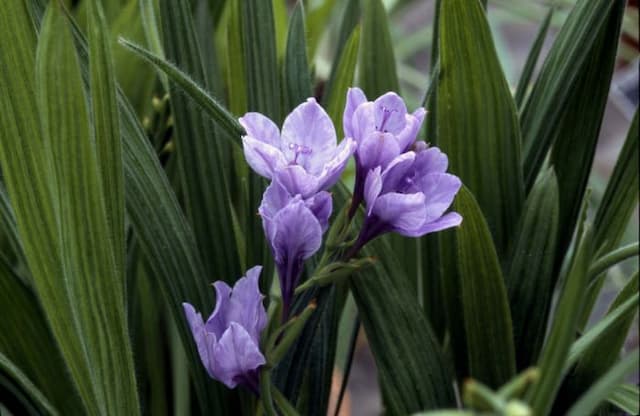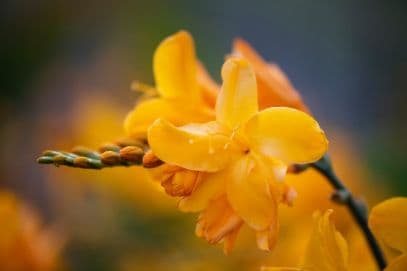Tall Bearded Iris Iris 'Orange Dawn' (TB)

ABOUT
The Iris 'Orange Dawn' is a captivating plant showcasing a vibrant display of flowers that boast a tantalizing blend of colors, primarily featuring shades of orange. The blooms are characterized by their classic iris form, consisting of three upright petals known as 'standards' and three downward-curving petals referred to as 'falls'. This striking contrast creates a visually stimulating display with the falls often bearing a lighter hue or intricate veining that enhances their charm. The heart of the flower usually displays a touch of a contrasting color, such as yellow or white, offering a beacon-like effect that draws the eye to the center of the bloom. The foliage of the Iris 'Orange Dawn' is equally elegant, with long, sword-shaped leaves that gracefully arch away from the center of the plant. The leaves have a fresh, green color that complements the warm tones of the flowers and accentuates their beauty. These leaves sprout from a firm base, forming a lush backdrop for the dramatic blossoms. The overall combination of the striking flowers and the verdant foliage render the Iris 'Orange Dawn' a stunning specimen in any garden setting where it adds a burst of color and a touch of sophistication.
About this plant
 Names
NamesFamily
Iridaceae
Synonyms
Tall Bearded Iris, Bearded Iris
Common names
Iris 'Orange Dawn' (TB).
 Toxicity
ToxicityTo humans
The common name of Iris 'Orange Dawn' (TB) is Bearded Iris. Bearded Irises are not considered highly toxic to humans, but they can cause mild stomach upset if ingested. The rhizomes contain irisin, iridin, or irisine, which can induce nausea, diarrhea, or vomiting. Contact with the sap may cause skin irritation or an allergic reaction in some individuals.
To pets
The common name of Iris 'Orange Dawn' (TB) is Bearded Iris. Bearded Irises are considered toxic to pets, including dogs and cats. Ingestion of the rhizomes can cause symptoms such as salivation, vomiting, drooling, lethargy, and diarrhea. It's important to prevent pets from chewing on any part of the plant, and to seek veterinary care if ingestion occurs.
 Characteristics
CharacteristicsLife cycle
Perennials
Foliage type
Deciduous
Color of leaves
Green
Flower color
Orange
Height
2-3 feet (60-90 cm)
Spread
1-2 feet (30-60 cm)
Plant type
Bulb
Hardiness zones
3-9
Native area
Europe
Benefits
 General Benefits
General Benefits- Enhances garden aesthetics: The Iris 'Orange Dawn' features vibrant orange blooms that add a splash of color and visual interest to any garden.
- Attracts pollinators: The bright flowers are appealing to bees, butterflies, and other important pollinators, helping to support the local ecosystem.
- Drought tolerance: Once established, this Tall Bearded Iris can tolerate periods of drought, making it suitable for xeriscaping or low-water gardens.
- Low maintenance: Irises are generally low maintenance, requiring minimal care once they are properly planted and established.
- Perennial growth: As a perennial, the Iris 'Orange Dawn' will return year after year, offering long-term value for gardeners.
- Seasonal interest: This iris blooms in late spring to early summer, providing seasonal interest and marking the transition from spring to summer blooms.
- Versatile planting options: They are suitable for borders, cottage gardens, and can also be grown in containers for those with limited space.
- Cut flower potential: The striking flowers make beautiful cut arrangements for indoor enjoyment.
 Medical Properties
Medical PropertiesThis plant is not used for medical purposes.
 Air-purifying Qualities
Air-purifying QualitiesThis plant is not specifically known for air purifying qualities.
 Other Uses
Other Uses- Photography Subject: Iris 'Orange Dawn' is popular among photographers due to its vibrant colors, providing a beautiful subject for botanical and garden photography.
- Garden Themed Art: Artists often use the striking forms and colors of the Iris 'Orange Dawn' as inspiration for paintings, drawings, and garden-themed artwork.
- Culinary Garnish: The petals of Iris 'Orange Dawn' can be used as a colorful garnish for salads and desserts, although they should be used sparingly as they can have a slightly bitter taste.
- Eco-friendly Dye: The petals and other plant parts can be used to create natural dyes for fabrics, yarns, and crafts, offering a range of orange and purple hues.
- Floral Water: Petals can be soaked in water to create a lightly scented Iris floral water for use in homemade cosmetics or room fresheners.
- Creative Crafts: Dried Iris petals can be used in potpourris, homemade paper making, or pressed flower arrangements for decor and keepsakes.
- Garden Design: Iris 'Orange Dawn' can be used as a living paintbrush to add splashes of color in garden bed designs, creating vivid seasonal displays.
- Edging Plants: They can be used as border plants along garden pathways due to their size and striking color, clearly defining garden spaces.
- Companion Planting: Iris 'Orange Dawn' can be paired with other perennials that have contrasting foliage or flowering time to extend the garden's interest.
- Teaching Tool: These Irises can be used in educational settings to teach about plant biology, hybridization, and the importance of pollinators.
Interesting Facts
 Feng Shui
Feng ShuiThe Iris is not used in Feng Shui practice.
 Zodiac Sign Compitability
Zodiac Sign CompitabilityThe Iris is not used in astrology practice.
 Plant Symbolism
Plant Symbolism- Hope: The Iris often symbolizes hope, signifying expectations for positive things to come.
- Wisdom: Associated with the Greek goddess Iris, the flower is also a symbol of wisdom celebrated in various cultures.
- Purity: The elegance of the iris imparts a sense of purity, often used in religious contexts and spiritual occasions.
- Courage: The bold color of 'Orange Dawn' can represent courage and the strength to face new challenges.
- Royalty: Iris flowers have been linked with kings and royal families throughout history, partially due to their regal appearance.
 Water
WaterTall Bearded Iris should be watered deeply to encourage root growth, but only as needed, which typically means when the top inch of soil feels dry to the touch. During the growing season, this might be once a week, depending on the climate and weather conditions. Each watering session should involve soaking the soil with approximately one inch of water, equating to about half a gallon per square foot. During the hot, dry periods, watering frequency may increase. Avoid overhead watering to prevent leaf spot diseases, and reduce watering once the plant has finished blooming for the season.
 Light
LightTall Bearded Iris thrives in full sunlight, which means it needs at least 6 hours of direct sunlight each day. The ideal spot for this iris is an area that receives morning sun and afternoon sun, ensuring the flowers produce vibrant colors and sturdy stems. Partial shade, especially during the hottest part of the day, is acceptable but may reduce the plant's bloom.
 Temperature
TemperatureTall Bearded Iris is hardy and can manage temperatures that range from approximately -30 to 90°F, although they flourish in the temperature spectrum of 40 to 80°F. They can withstand cold winter temperatures well below freezing but should be protected from extreme heat and humidity. The ideal temperature for promoting growth is between 60 and 70°F.
 Pruning
PruningPruning of Tall Bearded Iris should be done to remove dead or diseased foliage and to maintain plant health. The best time to prune is after blooming, cutting flower stems close to the base. In late fall, trim leaves to a height of about 4 to 6 inches to prepare the plant for winter and to remove any foliage that can harbor pests or diseases. Pruning should be done annually.
 Cleaning
CleaningAs needed
 Soil
SoilThe Tall Bearded Iris 'Orange Dawn' prefers well-draining, loamy soil enriched with compost. The ideal soil pH for this iris should be slightly acidic to neutral, between 6.1 and 7.0.
 Repotting
RepottingTall Bearded Irises like 'Orange Dawn' rarely need repotting. Typically, they should be divided and replanted every 3 to 5 years to prevent overcrowding and rejuvenate the plant's vitality.
 Humidity & Misting
Humidity & MistingTall Bearded Iris 'Orange Dawn' tolerates typical outdoor humidity levels well and does not require specific humidity adjustments.
 Suitable locations
Suitable locationsIndoor
Place in a sunny spot and ensure good air circulation for Bearded Iris.
Outdoor
Plant in sunny area with well-draining soil and space rhizomes apart.
Hardiness zone
3-9 USDA
 Life cycle
Life cycleThe life cycle of the Iris 'Orange Dawn' (Tall Bearded Iris) begins with seed germination, typically in late summer or autumn, where the seed develops a small root system and a shoot. Following germination, the plant enters a vegetative stage, growing leaves and establishing a robust root system; this may continue for a couple of years before it reaches maturity. When mature, the Iris 'Orange Dawn' will start producing distinctive tall and sturdy flower stalks in the spring, which bear the ornate orange blooms for which it is named. After flowering, the plant sets seed contained within a capsule, which, when mature, splits open to release seeds for dispersal. Simultaneously with seed production, the plant's rhizomes (horizontal stems) grow and can be divided for vegetative propagation. The foliage of the Iris 'Orange Dawn' may die back in the winter, entering a period of dormancy, only to re-emerge in the following spring to repeat the cycle.
 Propogation
PropogationPropogation time
Late Summer to Fall
The Tall Bearded Iris 'Orange Dawn' is commonly propagated through division, which is best done late in the summer after the plant has bloomed and begins to go dormant. To propagate by division, the clump should be carefully dug up and the rhizomes separated, ensuring that each division has at least one fan of leaves and healthy roots. The divested rhizomes can then be replanted approximately 12 to 24 inches apart to allow for ample growing space. It’s important to plant the rhizome pieces so that the tops are slightly exposed to the sun, allowing them to dry out to prevent rot. This method of propagation is favored as it helps maintain the vigor of the plant and also provides a way to rejuvenate older clumps that may have stopped flowering prolifically.









